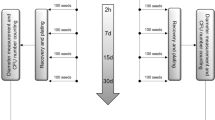Summary
Benomyl applied to the seeds of soybean (Glycine max L. Merrill) inoculated with a benomyl resistant strain ofRhizobium japonicum increased the relative abundance of nodules formed by the inoculum strain and the numbers of the added rhizobium on the roots, the total N content, the percentage N, the yield at one plant density and, in one of four soils, the pod weight of soybeans grown in the greenhouse. Oxamyl applied to the seeds, foliage or both of soybeans inoculated with an oxamyl resistant strain ofR. japonicum increased the yield, N content, percentage N, and weight of nodules, pods and grain and enhanced the relative frequency of nodules formed by the inoculum strain. It is suggested that pesticides or other antimicrobial agents and rhizobia resistant to these inhibitors may provide a new means for increasing nitrogen fixation by soybeans.
Similar content being viewed by others
References
Diatloff A 1970 The effects of some pesticides on root nodule bacteria and subsequent nodulation. Aust. J. Exp. Agric. Anim. Husb. 10, 562–567.
Dobereiner J 1978 Potential for nitrogen fixation in tropical legumes and grasses.In Liminations and Potentials for Biological Nitrogen Fixation in the Tropics. Eds. J Dobereiner, R H Burris and A Hollaender. Plenum Press, New York, pp 13–24.
Fisher D J 1976 Effects of some fungicides onRhizobium trifolii and its symbiotic relationship with white clover. Pestic. Sci. 7, 10–18.
Hale C N 1976 Some factors affecting the survival ofRhizobium trifolii on white clover. Proc. N. Z. Grassld. Assoc. 38, 182–186.
Halleck F E and Cochrane V W 1950 The effect of fungistatic agents on the bacterial flora in the rhizosphere. Phytopathology 40, 715.
Ham G E, Caldwell J B and Johnson H W 1971 Evaluation ofRhizobium japonicum inoculants in soils containing naturalized population of rhizobia. Agron. J. 63, 301–303.
Hely F W, Bergersen F J and Brockwell J 1957 Microbial antagonism in the rhizosphere as a factor in the failure of inoculation of subterranean clover. Aust. J. Agric. Res. 8, 24–44.
Hussain A and Vancura V 1970 Formation of biologically active substances by rhizosphere bacteria and their effect on plant growth. Folia Microbiol. 15, 468–478.
Kuykendall L D and Weber D F 1978 Genetically marked Rhizobium identifiable as inoculum strains in nodules of soybean plants grown in fields populated withRhizobium japonicum. Appl. Environ. Microbiol. 36, 915–919.
Lennox L B and Alexander M 1981 Fungicide enhancement of nitrogen fixation and colonization ofPhaseolus vulgaris byRhizobium phaseoli. Appl. Environ. Microbiol. 41, 404–411.
Madsen E L and Alexander M 1982 Transport of Rhizobium and Pseudomonas through soil. Soil Sci. Soc. Am. J. 46, 557–560.
Martin R A and Edgington L V 1981 Comparative systemic translocation of several xenobiotics and sucrose. Pestic. Biochem. Physiol. 16, 87–96.
Meister R T (ed) 1983 Farm chemicals handbook. Meister Publishing Co., Willoughby, Ohio.
Obaton M 1977 Effectiveness, saprophytic and competitive ability: three properties of Rhizobium essential for increasing the yield of inoculated legumes.In Biological Nitrogen Fixation in Farming Systems of the Tropics. Eds. A Ayanaba and P J Dart. Wiley, New York. pp 127–133.
Odeyemi O and Alexander M 1977 Use of fungicide resistant rhizobia for legume inoculation. Soil Biol. Biochem. 9, 247–251.
Ramirez C and Alexander M 1980 Evidence suggesting protozoan predation on Rhizobium associated with germinating seeds and the rhizosphere of beansPhaseolus vulgaris L.) Appl. Environ. Microbiol. 40, 492–499.
Rao A V and Sharma R L 1978 Influence of chemicals on the microflora and enzyme activities in the cauliflower rhizosphere. Acta. Bot. Indica. 6, 71–74.
Tu C M 1980 Effect of fungicides on growth ofRhizobium japonicum in vitro. Bull. Environ. Contam. Toxicol. 25, 364–368.
Vincent J M 1970 A Manual for the Practical Study of the Root-Nodule Bacteria. Blackwell Scientific Publications, Oxford.
Vincent J M 1980 Factors controlling the legume-Rhizobium symbiosis.In Nitrogen Fixation. Vol. II. Eds. W E Newton and W H Orme-Johnson, University Press, Baltimore, Maryland. pp. 103–129.
Author information
Authors and Affiliations
Rights and permissions
About this article
Cite this article
Maqbul Hossain, A.K., Alexander, M. Enhancing growth and nitrogen uptake by soybeans using pesticides. Plant Soil 81, 133–141 (1984). https://doi.org/10.1007/BF02206902
Received:
Issue Date:
DOI: https://doi.org/10.1007/BF02206902




